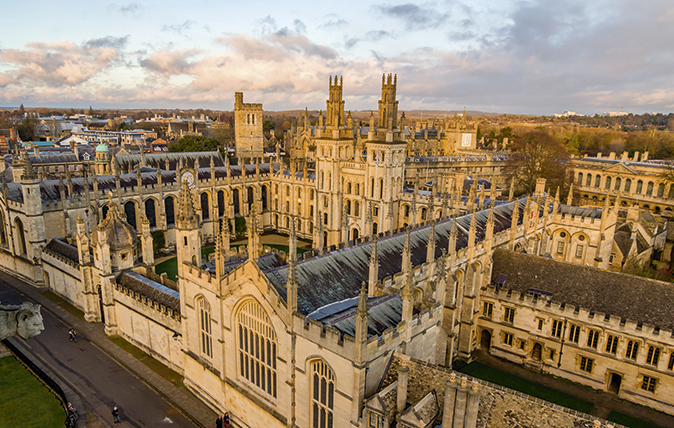The best places to invest in student property
With Britain’s top universities performing better than ever, Carla Passino discovers the best places to invest in student property.


Oxford University rocked the academic world last month, when it wrestled the top spot of the Times Higher Education (THE) rankings away from America’s Caltech, the five-consecutive-year champion. This is the first time in the 12-year history of the prestigious league table that a British university has taken the lead. Oxford’s success looks set to further boost the international appeal of British higher education, which already enjoys an unrivalled reputation; all together, 32 British universities sit within the best 200 in the world.
For parents, these results mean not only that the UK offers great higher-education opportunities, but also that investing in a property close to a top-performing university makes good financial sense, because it can be let out once your children have graduated. However, returns on investment can vary from place to place. Here is how Britain’s top 10 universities rank from a property perspective, in order of rental return.
Acknowledgments: Knight Frank (research produced exclusively for COUNTRY LIFE) and Savills
University of Manchester
Eighth in Britain and 55th in the world, Manchester has the largest student community in the UK at about 40,000. This ensures a stream of demand for local flats, especially as property in the city is more affordable than in many other university towns; one- or two- bedroom flats within two miles of the Oxford Road campus cost an average of £154,950. Rental yields are some of the highest in the UK at 6.6%.
‘Manchester remains one of the best locations for buy-to-let,’ explains Graham Davidson of Sequre Property Investment (0800 011 2277). ‘A heavy student population keeps rental demand high all year round and the city’s vibrant atmosphere sees professionals and graduates drawn to live here on a permanent basis.’
Average yield: 6.6% Average price for one- and two- bedroom flat two miles from the University: £154,950 Average rent: £850 Growth to date for the local authority: 25.8% Growth prospects for the entire region 2016–20: 13.7%
Sign up for the Country Life Newsletter
Exquisite houses, the beauty of Nature, and how to get the most from your life, straight to your inbox.
University of Edinburgh
Scotland’s top university ranks 27th in the overall THE chart and sixth in the UK. Edinburgh appeals to parents looking to invest in a university pad, thanks to reasonable prices and high yields.
According to Michael Hodgson of Strutt & Parker (0131–226 2500), families tend to buy two- to five- bedroom flats within walking distance of the university in areas such as Marchmont, Bruntsfield, Newington, Old Town, New Town and Stockbridge.
‘This is a city people are drawn to and many keep the flats after the children have finished university,’ adds Edward Douglas-Home of Knight Frank (0131– 516 8502). ‘They then use them as a holiday home or buy-to-let investment.’
Average yield: 5.6% Average price for one- and two- bedroom flat two miles from the University: £169,950 Average rent: £800 Growth to date for the local authority: 12.4% Growth prospects for the entire region 2016–20: 14.2%
University of Warwick
As 82nd overall and 10th in the UK, Warwick is the perfect place for parents to buy a student property. Rents are low at £598, but prices for one- and two- bedroom homes within two miles of the Coventry campus are the most afford- able among Britain’s top 10 university locations at £143,000, with an attractive return on investment of more than 5%.
Average yield: 5% Average price for one- and two- bedroom flat two miles from the University: £143,000 Average rent: £598 Growth to date for the local authority: 33% Growth prospects for the entire region 2016–20: 16.5%
University of Bristol
With a remarkable 71st spot in the THE league table, Bristol is not only a leader in academia, but also in environmental conscience—in September, it won a UNESCO award for its Green Impact programme, which encourages British universities to be more eco-friendly.
A student body of 23,000 fuels demand for smaller flats. As an example, says James Toogood of Knight Frank (0117– 911 2893), ‘a property currently on the market has received 20% more viewings from parents looking for their children’. Rental returns are robust at an average of 4.4% and capital growth looks set to remain solid. ‘There is a genuine shortage of stock and we have seen an increase of 67% in the number of new applicants compared to last year.’
Average yield: 4.4% Average price for one- and two- bedroom flat two miles from the University: £250,000 Average rent: £925 Growth to date for the local authority: 44.1% Growth prospects for the entire region 2016–20: 19.9%
Oxford University
Exceptional quality of research, a firm international outlook and huge success in transferring knowledge to other industries propelled Oxford to the top of the 2016–17 THE league table.
As well as being a beacon of innovation for local companies, the university is also an important driver of the city’s property market. ‘We often see parents buying for their children,’ says William Kirkland of Knight Frank in Oxford (01865 790077). ‘Most people will hold onto the property and let it in the long term or do short-term lets and use it themselves for weekend breaks.’
According to Giles Lawton of Strutt & Parker (01865 366660), university- driven demand is strongest for either flats or Victorian terraces located south, west and east of the city centre. Multi- occupancy student accommodation in east Oxford (London Road, Cowley Road and Iffley Road) offers gross yields of more than 6%. More traditional rents can bring in 3.5% to 4%. Future value growth also looks promising, thanks to high demand and low supply.
Average yield: 4.2% Average price for one- and two- bedroom flat two miles from the University: £325,000 Average rent: £1,150 Growth to date for the local authority: 44.5% Growth prospects for the entire region 2016–20: 21.6%
Cambridge University
Cambridge is firmly entrenched in the fourth spot on the THE list (second in the UK). The city itself has become Britain’s Silicon Valley, with flourishing tech and medical companies, so property is slightly more expensive here than in most other top university towns.
‘We sell a number of the smaller one- bedroom flats to investors and those looking for accommodation for their children who are coming here to study,’ says Cameron Ewer of Strutt & Parker (01223 459501). ‘Parents tend to buy at least a year before their children attend university and let the property out, as yields in the city have historically been very good.’ However, he cautions, ‘interest in flats seems to have slowed down lately, other than those looking for a pied-à-terre.’
Average yield: 3.9% Average price for one- and two- bedroom flat two miles from the University: £340,000 Average rent: £1,100 Growth to date for the local authority: 59.9% Growth prospects for the entire region 2016–20: 21%
Central London universities
With four universities within the THE top 40—Imperial College (eighth), University College London (15th), the London School of Economics and Political Science (LSE, 25th) and King’s College (36th)—the capital is a centre of excellence for higher education.
From a property viewpoint, parents need to weigh high prices and low rental yields with the opportunity of helping their children into the central London market. Although capital appreciation prospects for 2016 and 2017 are low, central London has historically seen a consistent growth in values.
For example, Laurence Lai of Knight Frank (020–3740 8685)—who always sees ‘a steady stream’ of parents looking to buy a one- or two-bedroom apartment before the start of term at Imperial College—says that ‘this would be a very good time to purchase as prices in South Kensington are at the lowest that they have been for three years.’
Average yield: From 3.0% to 3.2% Average price for one- and two- bedroom flat two miles from the universities: From £900,000 (LSE, King’s) to £999,950 (Imperial) Average rent: From £2,383 (LSE, King’s) to £2,492 (Imperial) Growth to date for the local authority: 64.5% Growth prospects for the entire region 2016–20: 15.3%
Carla must be the only Italian that finds the English weather more congenial than her native country’s sunshine. An antique herself, she became Country Life’s Arts & Antiques editor in 2023 having previously covered, as a freelance journalist, heritage, conservation, history and property stories, for which she won a couple of awards. Her musical taste has never evolved past Puccini and she spends most of her time immersed in any century before the 20th.
-
 You're all invited to Cecil Beaton's Garden Party
You're all invited to Cecil Beaton's Garden Party'The space given over to 'Cecil Beaton’s Garden Party' at the Garden Museum is smaller than Beaton’s own drawing room, but its intimacy is its trump card.'
By Charlotte Mullins Published
-
 Chelsea Flower Show 2025: Ten things not to miss in what promises to be a superb year at the world's greatest horticultural show
Chelsea Flower Show 2025: Ten things not to miss in what promises to be a superb year at the world's greatest horticultural showIt promises to be a stellar year at the RHS Chelsea Flower Show. Kathryn Bradley-Hole previews some of the highlights you can expect, while we take a look ahead to what Country Life will be up to during the week.
By Kathryn Bradley-Hole Published
